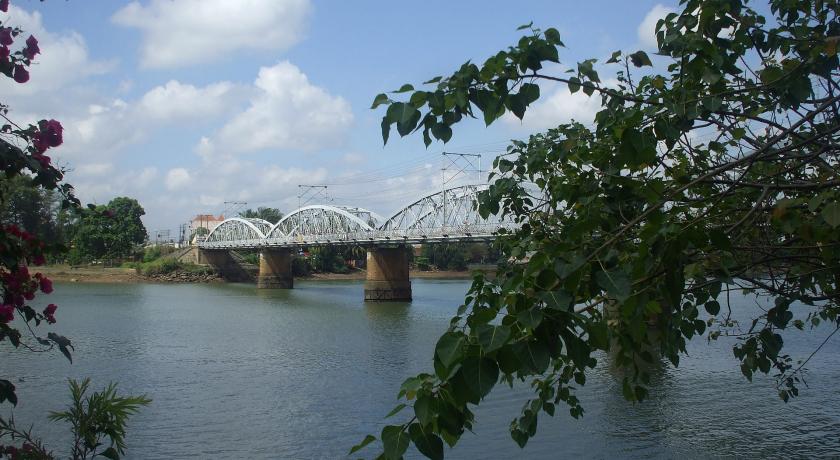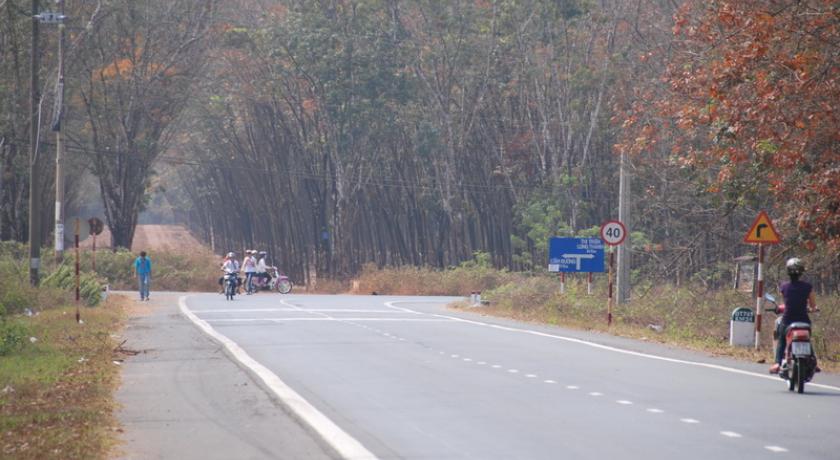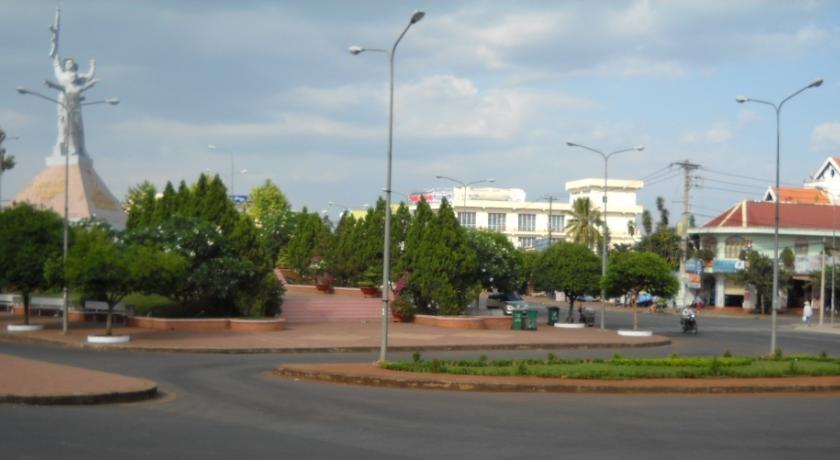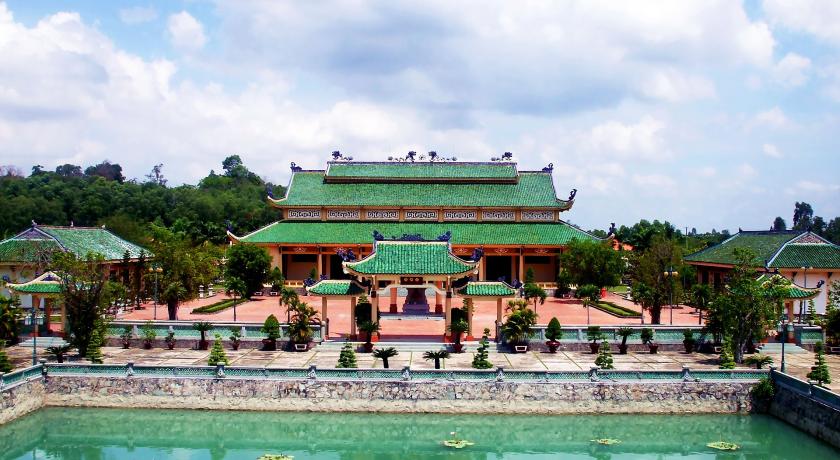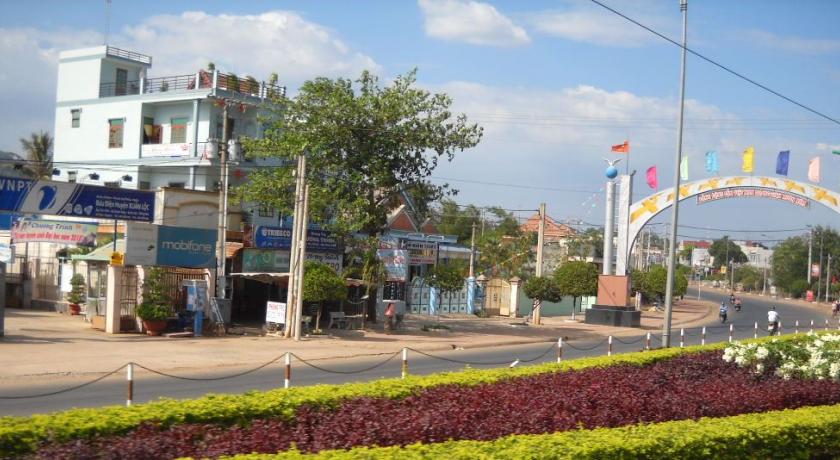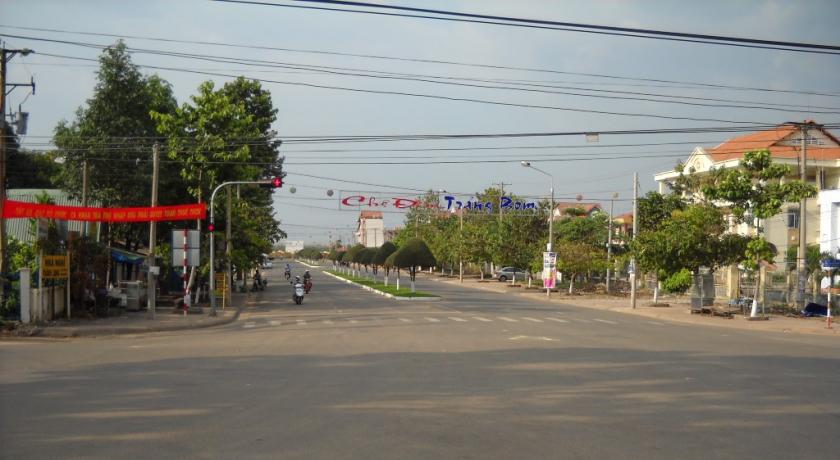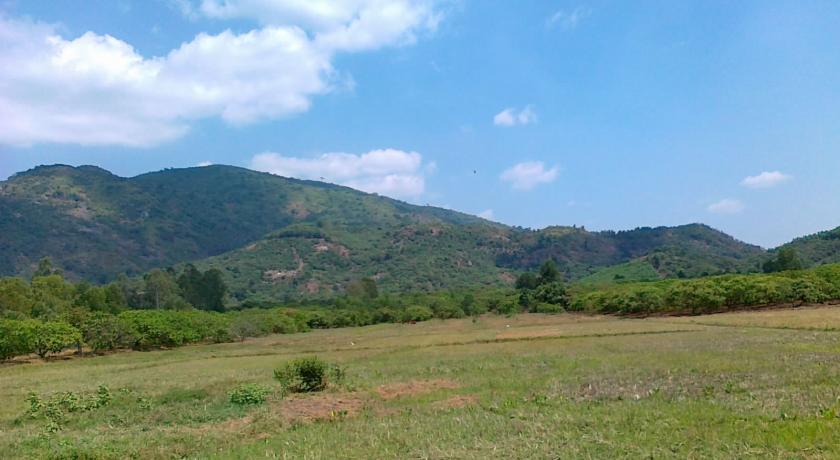Description
Đồng Nai is a province in the Southeast region of Vietnam, located east and northeast of Ho Chi Minh City (Saigon). The largest city in Đồng Nai is Biên Hòa.
Prior to Vietnamese colonization, the area was part of Cambodia until 1627. The area was known as Kâmpéâp Srâkatrey (កំពាប់ [កំពប់] ស្រកាត្រី) in Khmer.
Administrative divisions
Đồng Nai is subdivided into 11 district-level sub-divisions:
- 9 districts:
- Cẩm Mỹ
- Định Quán
- Long Thành
- Nhơn Trạch
- Tân Phú
- Thống Nhất
- Trảng Bom
- Vĩnh Cửu
- Xuân Lộc
- 1 district-level town:
- Long Khánh
- 1 provincial city:
- Biên Hòa (capital)
They are further subdivided into 8 commune-level towns (or townlets), 136 communes, and 29 wards.
Demographics
Đồng Nai is one of Vietnam's most populous provinces (ranked 5) with a recorded population of 2,486, 154 in the 2009 census and an official estimated population of 2,905,800 in 2015.
Its population has been growing rapidly in recent years, mainly driven by migrant workers coming to the province to work in factories. Population growth was 1.95% in 2005, between 2.5% from 2008 to 2010 and 3.5% in 2011. Net migration contributed 2.2% to this figure. Đồng Nai is second only to Bình Dương Province in both population growth and net migration.
The population of Đồng Nai is primarily the dominant Kinh (Viet) ethnicity, although there are residents of the Chinese, Nùng, Tay, and Cham minorities...
Geography
Đồng Nai is situated in southeastern Vietnam and bordered by: Bình Thuận, Lâm Đồng, Bình Dương and Bình Phước, Bà Rịa–Vũng Tàu, and Ho Chi Minh City (Saigon). Đồng Nai province has an advanced traffic system with many backbone national roads crossing, such as: National route 1A, national route 20, National route 51, North–South railway lines; Located adjacent to the Saigon Port and Tan Son Nhat International Airport, it offers many advantages to economic activities in the area. Its location is very important for the development of the Southern economic main hub and a junction of the South Eastern and Tây Nguyên Highland.
Đồng Nai Province is based essentially on a system of lakes, dams and rivers, of which Trị An Lake with 323 km² and over 60 rivers, rivulets and canals are very favorable for the development of a number of aquatic products: raft bred fish and shrimp. Nam Cát Tiên prohibited forest that has been recognized as an international bio reservation zone is located in the north of Đồng Nai. From the mountainous area, Đồng Nai River, an inland waterway, flows southeast through Biên Hòa City, Ho Chi Minh City, and villages along its way. This river plays an important role on supplying fresh water for the whole area.
Climate
Đồng Nai lies in the monsoon tropical zone and is affected by the north-east and south-west monsoon. It is also under the influence of Pacific Ocean tropic atmosphere between April and October. Climate is divided in two distinct seasons. The rainy season lasts from March or April to November and the dry season from December to March or April of the following year. Average temperature is between 23.9 and 29.0 °C, much lower than standard level of the tropical regions (26-30 °C). Its annual rainfall is quite high with 1,500 - 2,700 mm.
On average, the weather is sunny for 4.0-9.5 hours per day. Total rainy days within a year are between 120 and 170 days (standard level of tropical region is 150–160 days) with total rainfall of some 1,500 - 2,750 mm. The average humidity is around 80 - 82% and humidity in the dry season is 10-12%, lower than that of the rainy season.
Đồng Nai Province's weather with regular sunshine, rain, and high humidity, equally found in the localities, facilitates agricultural production and development of industry and cultural and tourism activities.
Resources
Đồng Nai is plentiful with forest resources, granite mines, construction stone, clay, kaolin, pozzolan, sand, gravel, etc.
Economy
Đồng Nai is one of Vietnam's main manufacturing centers and one of the most developed provinces.
Agriculture
Despite its strong focus on industrial development, Đồng Nai still has a substantial agricultural sector. Agricultural land accounts for 47% of the province's area as of 2011, a total of 277,600ha. This is lower than in other provinces in the Southeast region, except for Ho Chi Minh City.
Cereals were grown on 118,600ha in 2011, an area that has been decreasing gradually in recent years, from 139,300ha in 2005. Output of rice has however remained stable and was at 335,200t in 2011. The province also produced 305,300t of maize, making it the largest producer of maize outside the country's mountainous regions and contributing 6.3% to the national maize output. Đồng Nai also produced 619,700t of sugar cane (3.5% of the national output), sweet potatoes and cassava.
Đồng Nai is the largest livestock producer among Vietnam's provinces and plans to further invest in the sector.The government reserved 15,000ha for livestock farming in 2012, mostly for poultry and pigs. In 2011 there were 1.33 million pigs and 10.655 million poultry. Despite not being located along the coast, Đồng Nai produced 41,600t of fishery products in 2011. Over 90% of this was produced in 33,500ha of aquaculture farms. This makes Đồng Nai the largest aquaculture producer outside the Mekong Delta.
Industry
Đồng Nai is one of Vietnam's main manufacturing centers. It has attracted 9.1% of FDI into Vietnam by 2011, an accumulated US$18.2 billion, the fourth largest after Ho Chi Minh City, Bà Rịa–Vũng Tàu Province and Hanoi. Industrial gross output in 2011 was VND 314 trillion, 10.6% of the national value. It has received a broad range of FDI projects, including a Bosch auto component plant, a Toshiba motor plant, a PepsiCo beverage factory, a Posco steel plant, and a Nestlé coffee factory.
Transportation
Đồng Nai has made significant progress in upgrading its transport infrastructure, especially roads. National highways in the province have a total length of 244.5 km and have been improved and widened up to level 1 and 2 standards (National Highway No 5 and 6) or up to third grade like National Highway No 20 to Da Lat. The total roads system in the province is 3.339 kilometers long, of which almost 700 kilometers are tar roads. All communes and wards are connected to the road network.
Under scheme in the near future, highways to Bà Rịa–Vũng Tàu Province and Ho Chi Minh City, a railway connecting Biên Hòa to Vũng Tàu, upgraded provincial roads No 726 and connecting national highway No 20 and No 1 with national highway No 51 will create a complete system, promoting socioeconomic development in the province and region.
A new airport, Long Thanh International Airport, is planned for construction in Long Thanh district, Đồng Nai, approximately 40 km northeast of Ho Chi Minh City. Upon completion, it will handle international flights in place of Tan Son Nhat International Airport, which will serve domestic flights.
Tourism
The local soil conditions are very suitable for the growth of cash crops and fruit trees. The 100-km coastline in Dong Nai is a natural reserve for different kinds of seafood. In addition this coast is endowed with two beautiful beaches (Long Hai and Phuoc Hai beaches) which attract many swimmers and holiday makers.
Dong Nai is also a major industrial complex with about 100 major plants and enterprises. The province is easily accessible by land, river and sea routes. It is endowed with many picturesque landscapes and tourist sites.
The Cham and Khmer people who live in the province hold their own typical festivals: the Royal Haji ritual of the Cham people, and the Chol Chnam Thmay Festival of the Khmer.
Giang Dien Waterfall Tourist Site: Giang Dien Waterfall Park is located about 1 1/2 hours from Ho Chi Minh City and about 40 minutes from Bien Hoa. The park's main attraction is the man-made waterfalls where visitors can climb on the rocks and let the cool water refresh their bodies on hot days. There are tent-like canopies around the falls that are available to rent for the day to get out from under the sun and enjoy a picnic. There are also lounge chairs to relax on. The park also has a large lake with paddle boats and other toys. There are gardens to explore, 3 restaurants, and tents to rent for overnight guests. It is a new park and very well maintained. It is a great place to escape from the city and relax for the day or the weekend.
Address: 104/4 Hoa Binh Hamlet, Giang Dien Commune, Trang Bom.
Tan Trieu Grapefruit (Pomelo) Village is an original place for visitors to experience nature and the Dong Nai river. Come and enjoy the specialties of Dong Nai fruits: Salad with grapefruit, grapefruit wine, chicken steamed grapefruit, a scenic boat trip on the Dong Nai river and enjoy other specialty fruits. Located in Tan Binh Commune, Vinh Cuu District, Dong Nai Province, about 40 kilometers from HCMC. From HCMC along Hanoi Highway heading to Bien Hoa City, tourists can reach the village by waterway or by National Road 24 for about four kilometers. The village lies on Tan Trieu Island embraced by the canals that receive water from the Dong Nai River. As the ground is flooded, locals cannot grow rice or vegetables but the island is fertile and the climate is rather cool and suitable to grow pomelo. Recently, with many people coming to the village, locals turn the pomelo garden into eco-tourism areas, of which the most striking is Nam Hue pomelo garden where visitors can experience food and drinks made from pomelo such as goi buoi (pomelo mixed with shrimp) and pomelo wine or juice.
Tan Trieu goi buoi has its own tasty attraction by traditional ingredients and formulas. Makers have to mix sugar-green-skin pomelo with shrimp and spices such as chili, onion and peanut. Enjoy the dish with banh trang (griddle cake) and some wine pomelo in the windy garden for an unforgettable experience. Pomelo wine is contained in ceramic jars made in the shape of pomelo trees.
Once visiting the pomelo village, travelers not only can pick pomelo but also take a boat trip along the canals under the shade of pomelo trees or go fishing.
Buu Phong Temple: Is an historic 17th century Buddhist temple. Bien Hoa is an up and coming city; this is evident from the work being carried out by the commune on bettering the parks and monuments. This is no exception. The Buu Phong is a lovely quiet temple surrounded by countryside and within a municipal park. Lovely, airy and bright; a good place to get out of Bien Hoa in just 10 minutes. In the surrounding area, there are further stupas and statues to see.
Buu Long Mountain Park: Nice landscaped park with cafes and paddle boats on the manmade waterfalls and lake, just off the highway. There are paddle boats and row boats for rent to go around the lake and you are also able to stop at some of the "islands" in the lake. The grounds are well maintained, lots of gardens with a variety of flowers, this is a great place for a picnic, or lunch at the restaurant.
Lung Thanh Golf Club: The Golf course is about 1hr15 mins drive from the Ho Chi Minh city, and cost only USD57 (green fee plus caddy) for a game. The course is quite scenic, the clubhouse & facilities are superb and the course is way stronger than its yardage would indicate.
A great variety on the Hills course with elevated tees, doglegs and palms strategically located.
Jungle Bike Adventure: (Viet King Fisher Company) runs private tours with a group of mtb riders in HCMC and the Jungle Biking Challenge.
Mango Garden Resort: A super place (especially children) for a short break out of the hot city, offering Ac bungalows with TV & fridge around 5000.000 VND. Set in a peaceful garden with serene lakes a spacious playground and invigorating swimming pool. You can try their savory crocodile and flavorsome ostrich or try their other specialty, fried fish and the sweet-and-sour gustatory ‘running chicken’ (free-range chicken) these foods are a rare commodity in Saigon. Packed with activities for adults and kids to play; you can ride on an ostrich, watch black bears bathe, play and eat within their compound of grass, bushes and a creek. There’s grass-skiing, four-wheeled cart sliding (similar to a go-kart but without the steering wheel), and cycling, explored the lake with the water-pedal boat or Kayak, enjoy watching the deer, antelopes and crocodiles.
Address: Ap Tan Cang, Xa Phuoc Tan, Bien Hoa 810000, Vietnam Tel: 84613968163
Dong Nai Culture And Nature Reserve: This ecotourism centre has good service and friendly staff, with spacious rooms, a great place to go trekking in the jungle.
Address: Hamlet 1, Ma Da commune, Vinh Cuu District, Bien Hoa 810000, VietnamTel:+84 (0) 613861290
Transportation
By Road
Bien Hoa City is 30km from Ho Chi Minh City, 1,684km from Hanoi following National Highway No.1A. It also is 278km from Dalat, 95km from Vung Tau, 198km from Can Tho.
By Train
Biên Hòa Railway Station is a railway station on the North–South Railway (Reunification Express)
From Bien Hoa station to Nha Trang station is about 400 Kilometers. There are 4 trains including SE4, SE22, SNT2 and SE6 (which belong to Reunification Express train) on this route. They depart every day and take about 7 hours.
From Bien Hoa station to Danang station is about 895 Kilometers. There are 3 trains including SE4, SE22 and SE6 (which belong to Reunification Express train) on this route. They depart every day and take about 16 hours.
The types of seats include the hard seat, the soft seat, the hard berth (6 berths) and the soft berth (4 berths), called cabin. Each of the cabins is designed with air-conditioner and the comfortable seat.
Train Station Address: Hung Dao Vuong street , Bien Hoa city, Dong Nai.
It takes about 34 Km ~ 60 minutes by taxi from Ho Chi Minh city to Bien Hoa station.
Please check link below for train times.
By Air
Tan Son Nhat International Airport (IATA: SGN, ICAO: VVTS), is the largest airport in Vietnam. It is located 4 mi (6 km) north of the center (District 1) of Ho Chi Minh City (Saigon).
Tan Son Nhat International Airport operates from two terminal buildings – Domestic Terminal 1 and International Terminal 2
By Ferry to Vung Tau
30 minutes drive from Bien Hoa to Bach Dang Port, then 1h 15 minutes ferry to Vung Tau.
By Bus
(Hoang Long Transit Co) Bien Hoa to Nha Trang 8 hrs 38 min $16-20 USD
(The Sinh Tourist Co) Bien Hoa to Nha Trang 10 hrs 48 min includes 1 hour transfer, stopping in Mui Ne
Bien Hoa to Mui Ne 4h 48m $7, Mui Ne to Nha Trang 5h $7. Total $14 USD
From Bien Hoa –Dong Nai- to Da Nang 20h 15m (Hoan Long Transit Co) 26-31$ USD
(Futa Bus Co) Bien Hoa ----to Mui Ne Binh Thuan 4Hours -------Da Lat Lam Dong------to Da Nang 18h
Bien Hoa to Mui Ne 7 $, Mui Ne to Da Lat 6$, Da Lat to Da Nang 12$
Total 28h 48 m, 25$ USD
Bien Hoa Bus Station Address: Nguyễn Ái Quốc, Quang Vinh, tp. Biên Hòa, Đồng Nai, Vietnam.
Source https://en.wikipedia.org/wiki/%C4%90%E1%BB%93ng_Nai_Province
https://vietnam-railway.com/train/route/train-from-bienhoa-to-nha-trang
Address
Bien Hoa
Vietnam
Lat: 11.068630219 - Lng: 107.167594910


